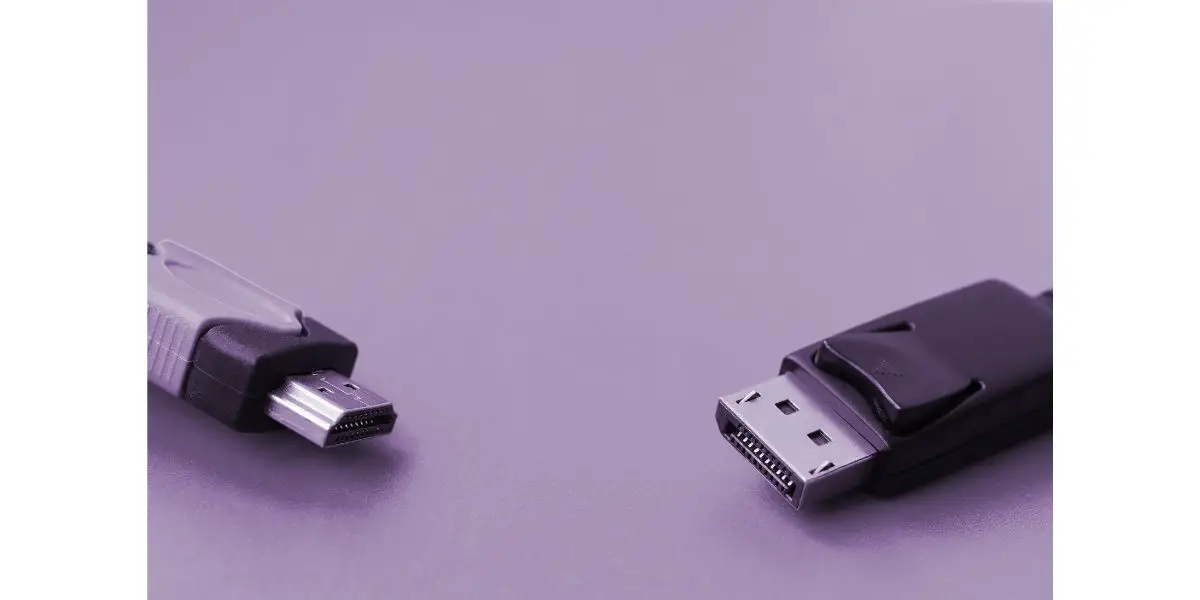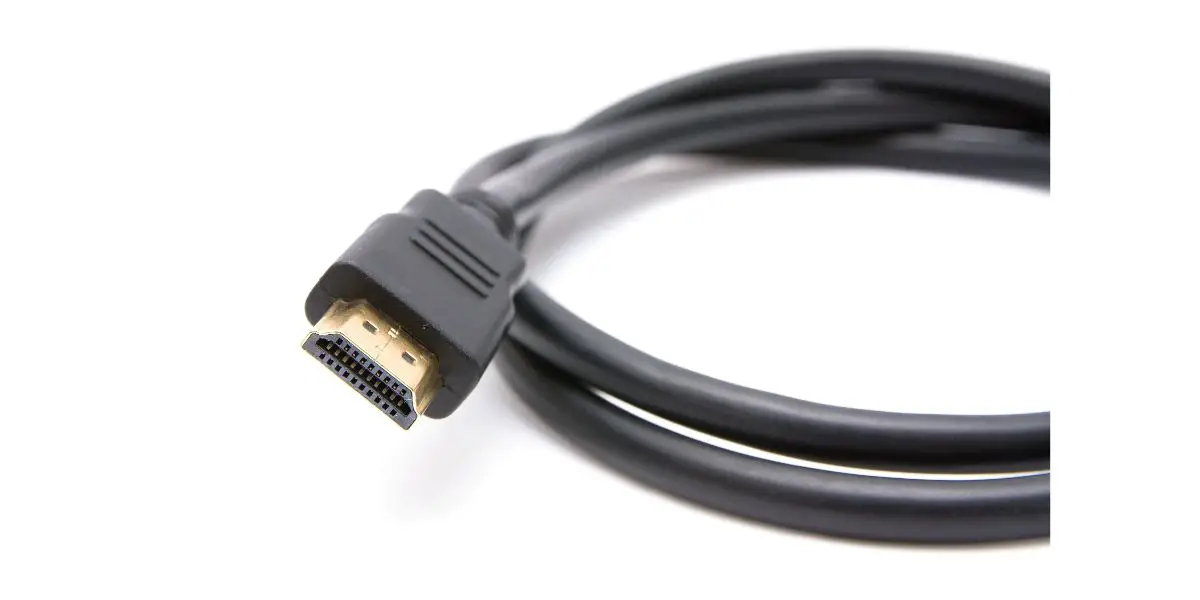Disclaimer: This post may contain affiliate links, meaning we get a small commission if you make a purchase through our links, at no cost to you. For more information, please visit our Disclaimer Page.
Connecting your laptop to your TV or monitor is a great way to view video content on the big screen. You could use your DisplayPort to make this connection, but not all laptops are compatible. There isn’t usually any quality loss if you use a DisplayPort to HDMI converter, but different models can handle different resolutions.
Table of Contents
How Converting DisplayPort to HDMI Affects Image Quality
In many cases, converting DisplayPort to HDMI is unnecessary. Most TVs and monitors come with HDMI ports that will functionally connect to your laptop for the same purpose. However, this may not apply to models from certain manufacturers.
You can buy a DisplayPort to HDMI adapter for a relatively low price. Most adapters do not affect image quality. This is because all that’s changing are the signal and voltage requirements, not the data being transmitted.
Note that DisplayPort to HDMI converters will list the resolutions they can handle in their product descriptions. If your image resolution exceeds your converter’s capacity, you won’t get a signal unless you use a video scaler.
In this sense, it’s not a question of image quality. It’s a question of whether or not the image appears at all.
How Do I Use DisplayPort to HDMI Adapter?
To use a DisplayPort to HDMI adapter, insert the DisplayPort cable into the DisplayPort end of the adapter and the HDMI end of the adapter into the desired HDMI port.
If your HDMI end has a small button, push it down and hold it down as you plug it in. The purpose of the small button on some HDMI plugs is to tightly secure the plug into the port.
You might be able to use multiple adapters if you have multiple ports, but this will make your system work harder and can lead to other errors if not done carefully.
Why Isn’t My DisplayPort to HDMI Converter Working?
Be aware that passive adapters only work with dual-mode DisplayPorts. You can tell if that’s the problem by checking to see if there is a DP++ symbol near your output. If you don’t have one, you’ll need an active adapter. We’ll discuss this item in more detail later in this article.
Assuming your converter is compatible with your DisplayPort, there are other reasons why you might not get your image.
- You purchased a model that can’t handle your desired resolution.
- You didn’t connect the cables correctly.
- One or more of your Display Drivers are outdated or corrupt.
- You might have to enable your device’s HDMI input.
- Your cable is frayed.
- Your output or input port is damaged.
- Your adapter has faulty hardware.
- Your adapter doesn’t support HDR.
How To Perform a Monitor Power Cycle
If you’re connecting to a monitor instead of a TV and you’ve diagnosed that corrupt software is the problem, you might be able to solve this issue by performing a monitor power cycle.
A power cycle is simply the technical term for a restart. However, you’ll need to do more than turn your monitor off and on again.
- Shut down your PC.
- Shut down and unplug your monitor from your PC and the wall.
- Unplug all output cables, including your converter.
- Wait for about 3-5 minutes.
- Plug your monitor back in, reconnect it to your PC, and turn both devices back on.
- Reconnect your output cables and converter to see if it makes a difference.
This process will reset your corrupt software. Unplugging your converter helps prevent power surges that could damage it during the reset process.
What’s the Difference Between a Passive and Active Adapter?
Passive adapters deliver the signal without converting it, while active adapters convert the signal. Passive shifters must pair with a different device that can convert signals.
In either case, image quality shouldn’t be an issue since neither shifter affects pixels. Again, it’s a matter of whether the image will appear or not.
According to Dell, you should always use an active adapter if adapting to multiple monitors. Many video and graphic cards can’t run DP++, which is needed for passive adapters.
Can You Convert HDMI to DisplayPort?
You can convert HDMI to DisplayPort, but it’s different than doing the opposite. You’ll need an active adapter, even if you have a dual-mode DisplayPort.
There are adapters on the market specifically for converting HDMI to DisplayPort, but they’re more expensive than DisplayPort to HDMI converters. This is simply because the internal conversion process is comparatively more complex.
HDMI and DisplayPort require different signals. HDMI uses TDMS, while DisplayPort uses LVDS. This is why you can’t simply plug an HDMI cable into a DisplayPort without a converter. It’s also why passive adapters only work with DP++ DisplayPorts. The DP++ port does the signal conversion.
An equivalent of DP++ doesn’t exist for HDMI. Therefore, a DisplayPort to HDMI conversion needs a “middleman” that converts the signal. Depending on your needs, you may need an active adapter with additional computing power beyond signal conversion.
Should You Always Opt for an Active Adapter?
You don’t always have to opt for an active adapter. They’re more versatile, but they’re also much more expensive. They also have a slightly longer loading time.
Given the evidence, it’s tempting to say that you should always opt for an adapter with active level shifting abilities.
This is true in some cases, like multiple monitors or a lack of DP++. However, active adapters are significantly more expensive than passive ones. Choosing a passive adapter will save you money if you don’t need an active one.
Potentially, an active adapter could have a longer load time than a passive one. This is simply because active converters do more work than passive ones. In most cases, this shouldn’t be an issue.
Why Am I Getting a Low-Quality Image?
Low image quality probably has nothing to do with the converter. Chances are an unrelated issue was affecting your monitor or TV when you attempted the conversion. Possible culprits include:
- Your monitor’s screen resolution. Check your computer’s display settings to adjust if needed.
- Your monitor’s refresh rate. If your converter’s signal doesn’t match your refresh rate, it won’t display properly.
- The image’s lower DPI is more noticeable on the larger screen. Increasing an image’s size won’t give it more pixels.
- You need to adjust your computer’s Color Calibration. How you do this depends on your device.
- Your monitor is using the incorrect display ratio. Adjust accordingly in your display settings.
- Your TV is underscanning or overscanning. This would give your image an odd aspect ratio or cut off part of the image. Adjust this in your TV’s settings.
- There’s an issue with your HDMI port. Try plugging your adapter into a different port to see if it changes your quality.
- Your original device’s output resolution doesn’t match your TV’s. A smart TV will attempt to adjust the device’s output resolution to make it match. The automatic process can have mixed results. Instead, adjust your original device’s output resolution yourself.
Conclusion
DisplayPort to HDMI conversion shouldn’t affect quality. If there is an issue with the conversion, the image won’t display. A low-quality image is more likely to appear because of something unrelated to the converter.
Admittedly, there’s always the rare possibility something else combined with the converter could be causing the quality problem. However, this is more of a compatibility issue than a converter issue.


